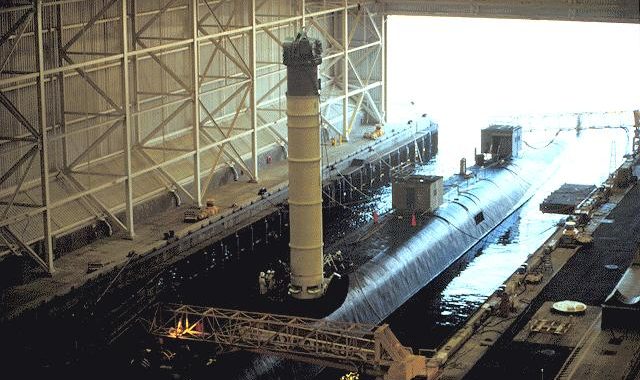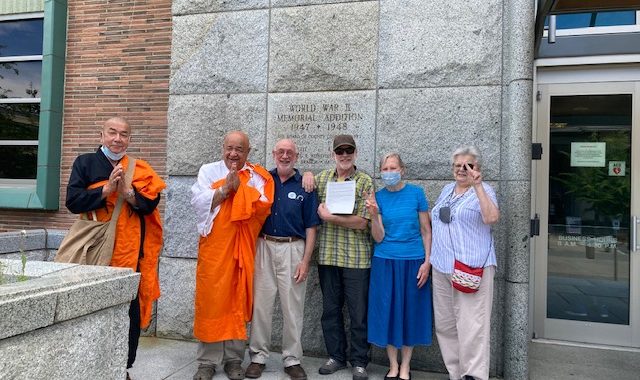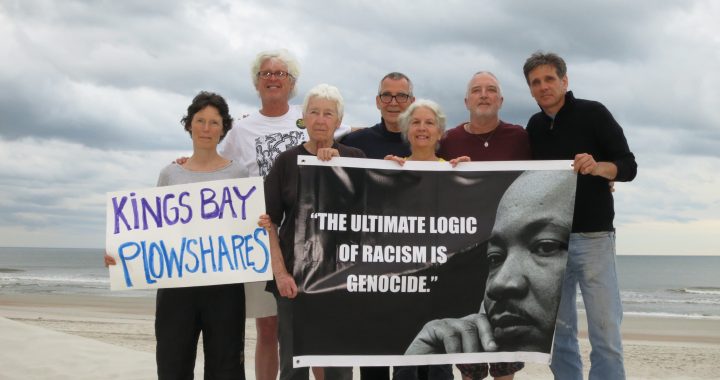NEWS RELEASE: October 29, 2020
Click here for PDF version of release
Contacts: Glen Milner 206-365-7865
Katherine George (attorney) 425-802-1052
James Lobsenz (attorney) 206-622-8020
On August 31, 2020, Judge Ronald B. Leighton ordered the release of eleven records that the Navy had provided to Plaintiffs in 2012 in the course of a National Environmental Policy Act (NEPA) lawsuit that were sealed later in 2012 in a secret court hearing. Judge Leighton also lifted a gag order imposed upon Plaintiffs over seven years ago.
Following the ruling by Judge Leighton, on October 23, 2020, Judge Thomas S. Zilly in the U.S. District Court in Tacoma ordered the Navy to pay legal fees incurred by two peace organizations to obtain the release of records, and to lift a gag order imposed upon them by the court since 2012 at the request of the U.S. Navy.
One of the plaintiff’s in the case, Ground Zero member Glen Milner stated recently, “On November 9, 2012, the Navy was able to have records and Plaintiff’s briefs sealed just days before oral arguments were scheduled in District Court. The records proved our arguments that the Navy never conducted a study of explosives risk for the second explosives handling wharf at Bangor and that the siting of the wharf failed to comply with explosive safety regulations. Our win on First Amendment issues in the Ninth Circuit and our recent wins in District Court are significant because we pushed back and succeeded in having the Court lift the permanent gag order that had been imposed over seven years ago. Still, the question remains—would Ground Zero have prevailed if the gag order had not been imposed, and the eleven records sealed, at the Navy’s request in District Court? We will never know.”
The NEPA lawsuit was initiated on June 19, 2012 in U.S. District Court in Tacoma by plaintiffs Ground Zero Center for Nonviolent Action and Washington Physicians for Social Responsibility.
Plaintiffs asserted that construction of the Navy’s second Explosives Handling Wharf began without an adequate study of environmental impacts under the NEPA. The Navy began construction of the four-year project in September 2012.
After the lawsuit was filed, the Navy released over 115,000 pages in its administrative record which helped to prove the Plaintiffs’ assertions that the Navy’s proposed second Explosives Handling Wharf would cause a new and substantial explosives risk in Hood Canal.
On November 8, 2012, the Navy secretly contacted the federal court regarding documents the Navy had filed in the administrative record that were being used by Plaintiffs to support arguments in their briefs. The Navy told the court that documents containing sensitive information relating to national security had been inadvertently released.
On November 9, 2012, eleven records were sealed, including two legal briefs previously filed by Plaintiffs, and a gag order was imposed on Plaintiffs. Four of the eleven records were cited in arguments that Plaintiffs intended to use in a hearing that was scheduled on November 12, 2012.
On January 8, 2014, Judge Leighton ruled to dismiss the NEPA lawsuit and Plaintiff’s claims against the gag order and the eleven sealed records. Plaintiffs appealed to the Ninth Circuit Court of Appeals.
On June 27, 2017, the Ninth Circuit ruled against Plaintiff’s NEPA claims but supported Plaintiff’s First Amendment claims against the gag order and the sealing of previously released records. The 9th Circuit Court of Appeals stated …that to impose continuing restrictions on Ground Zero’s public dissemination of documents that the Navy inadvertently made public, a court must identify “a compelling reason [to impose the restriction] and articulate the factual basis for its ruling, without relying on hypothesis or conjecture.” The Ninth Circuit vacated the decision by Judge Leighton and remanded the First Amendment issues regarding the gag order back to Judge Leighton’s court “for further proceedings to determine whether …restrictions on Ground Zero’s speech are warranted.”
On August 31, 2020, Judge Leighton stated in his new ruling, “…the Ninth Circuit …required this Court to make factual findings about the Navy’s claim that there were compelling reasons to allow it to “claw back” the documents it had already disclosed.
Ground Zero emphasizes that the Ninth Circuit already held that neither this Court nor the Navy can preclude the dissemination of any documents Ground Zero obtained from a source other than the Navy’s disclosure. It argues it obtained seven of the eleven documents at issue from a source other than the Navy.
…As to the remaining four documents, Ground Zero argues the Navy’s motion repeats and relies on an argument that the Ninth Circuit already rejected: that the documents’ status as UNCI or CISI material “protects it from disclosure.” The Ninth Circuit already held that the fact that it would have been protected from a FOIA request in the first instance is not enough to warrant a gag order after the government discloses it. 860 F.3d at 1262.
The Navy’s general reliance on the “risk” that the information could be useful to one seeking to harm the United States is similarly insufficient. The Ninth Circuit required specific facts supporting a finding that, absent restrictions on Ground Zero’s First Amendment rights, the
disclosure would cause harm. Ground Zero demonstrates that the Navy has not made such a showing; its witnesses all say it “could” do so.
…Ninth Circuit’s high standard for a gag order under these circumstances has not been met.”
In 2012, most of records that the Navy had filed in the administrative record for the NEPA lawsuit had been reviewed and redacted during a DoD review process. The records had not been requested by Plaintiffs in the case and had been provided by the Navy as evidence that the Navy had fully considered explosive risks for the second Explosives Handling Wharf. But instead of showing that the Navy had responsibly reviewed issues in its Environmental Impact Statement (EIS) for the wharf, the records proved the opposite. The records showed that the wharf did not comply with the Navy’s own explosives siting regulations and was never approved by the Department of Defense Explosives Safety Board (DDESB), the agency responsible for military explosives safety.
The released records proved that the Navy’s proposed second Explosives Handling Wharf would cause a new and substantial explosives risk in Hood Canal.
The eleven previously sealed records, unsealed on August 31, 2020
Four of the eleven sealed records showed that while the Navy stated in its EIS for the second Explosives Handling Wharf that there were no new risks involving explosive material in Hood Canal, a debate had been raging within the Department of Defense. The Department of Defense Explosives Safety Board (DDESB), had refused to grant approval for the project. The Navy instead sought its own Secretarial Certification, one of only seven such exemptions in the U.S., and agreed to accept all responsibility for any accident and the consequences of any accident for the entire life of the wharf.
Before records were sealed, Kitsap Sun reporter Ed Friedrich had used the four records for an October 1, 2012 article regarding the special Secretarial Certification exemption for the wharf.
Three of the eleven sealed records were portions of a U.S. Navy explosives manual, NAVSEA OP-5 Volume 1, Ammunition and Explosives Safety Ashore, that had been available on U.S. Navy websites many times since 2012. The manual proved that explosives siting claims made by the Navy throughout the EIS for the second Explosives Handling Wharf at Bangor did not comply with Department of Defense and U.S. Navy explosives safety regulations.
One of the eleven sealed records involved risk estimates for handling Trident II D-5 missiles and showed the amount of risk for detonation of first, second, and third stage rocket motors in the event of an accident at Bangor. The risk factors are based upon propellant tests from the 1990s and on a system of safety fault-tree analysis—a method of safety analysis now considered obsolete by many experts involved with complex risk assessment.
Two of the eleven sealed records did not address the second Explosives Handling Wharf, but instead were about siting requirements for SSGN submarines at Bangor. In an April 21, 2008 letter, the Department of Defense Explosives Safety Board withheld siting approval unless the Navy accepted responsibility for the explosive risks involving new SSGN activities.
One of the eleven sealed records was a 290-page record, Waterfront Functional Plan, 2009 Update, that was created for the Navy by MAKERS Architectural and Urban Design. This plan involved Navy Region Northwest activities.
On June 3, 2013, over six months after the eleven records were sealed and prohibited from use by Plaintiffs, the Navy filed replacement versions of the eleven sealed records. In most cases the records were either more heavily redacted than the original versions or completely withheld.
Judge Leighton’s August 31, 2020 order lifted the gag order imposed upon Plaintiffs in the case and ordered the release of all eleven records.
History of the NEPA lawsuit against the Navy’s second Explosives Handling Wharf
In May 2009, the Navy announced it was conducting an EIS for the second Explosives Handling Wharf. In March 2012, the Navy released its Final EIS and the Record of Decision was filed in May 2012.
The Navy’s second Explosives Handling Wharf consists of 1,250 pilings and covers 6.3 acres of water in ecologically sensitive Hood Canal. The Navy, while withholding information regarding explosives safety, will double the amount of explosives in Hood Canal and likely double the amount of missile handling by the Navy. The net explosive weight of the two wharves is equal to 7.4 million pounds of TNT in the form of rocket propellant in the missiles. The propellant is classified as an HC/D 1.1 explosive, more volatile than TNT, and is capable of detonating upon impact.
Throughout the EIS process, the Navy insisted that it was not increasing the risk of an accident involving missiles in Hood Canal. In the Final EIS the Navy stated, “No new or increased quantity of explosives would be introduced as a result of the construction and operation of the EHW-2.” The Navy also stated, as well as numerous other similar statements, “The proposed project would not change the amounts or manner in which explosive materials are handled on NBK at Bangor.” However, after the case was filed, the Navy released over 115,000 pages in its administrative record which proved the Plaintiffs’ assertions and showed a new and substantial risk in Hood Canal.
Other records released after the case was filed showed that the Navy planned to spend up to $32.2 million for “Impacted Facilities” to fortify or move existing facilities which could be damaged from an explosives accident at the new wharf. The expense amounts to about 4.5 percent of the entire project. But the Navy could not move or fortify the existing EHW. Mysteriously, the Navy completed a separate Environmental Assessment in 2011 which removed the fragmentation barrier between the wharves designed to prevent the propagation of an explosion at the adjacent wharf.
In September 2012, Plaintiffs discovered that while the Navy was informing the public that there were no new risks from explosive material, a debate had been raging within the Department of Defense. The agency in charge of explosives safety, the Department of Defense Explosives Safety Board, had refused to grant approval for the project. The Navy instead sought its own Secretarial Certification, one of only seven such exemptions in the U.S., and agreed to accept all responsibility for any accident and the consequences of any accident for the entire life of the wharf.
The January 8, 2014 District Court ruling did not address all of Plaintiffs’ concerns about the misleading EIS process. For example, the ruling was silent on whether the Navy violated a requirement to include comments of the Explosive Safety Board in the EIS which would have alerted the public to the danger of siting two missile-handling wharves close together.
Briefing for the 9th Circuit Court of Appeals was completed on October 6, 2014 and oral arguments were heard on May 6, 2016.
On June 27, 2017 a three-member panel of the 9th Circuit Court of Appeals issued a ruling affirming the district court’s order granting summary judgment, and stated, “The Navy violated NEPA’s public disclosure requirement by not revealing that the Safety Board withheld approval of its plan for the construction of EHW-2. The Navy further violated NEPA by withholding the now-disclosed portions of the appendices to the EIS. Both disclosure errors were, however, harmless.”
Near disaster at the Explosives Handling Wharf
An accident involving nuclear weapons occurred in November 2003 when a ladder penetrated a nuclear nosecone during a routine missile offloading at the Explosives Handling Wharf at Bangor. All missile-handling operations at SWFPAC were stopped for nine weeks until Bangor could be recertified for handling nuclear weapons. Three top commanders were fired but the public was never informed until information was leaked to the media in March 2004.
Public responses from governmental officials to the 2003 missile accident were generally in the form of surprise and disappointment.
Attorneys and public involvement in the case
Attorneys for the Plaintiffs, Katherine George and James Lobsenz, have a long history in open government and First Amendment issues.
Attorney Katherine George has been involved in Ground Zero v Navy since 2011. George previously conducted District Court briefing for the Freedom of Information Act (FOIA) lawsuit, Milner v Navy, that led to the U.S. Supreme Court decision overturning the High 2 FOIA exemption, which until 2011 had been increasingly used by the Navy and other federal agencies to withhold information from the public.
Attorney James Lobsenz became involved in Ground Zero v Navy in 2012, after the Navy secretly approached the District Court and obtained a gag order against Plaintiffs, preventing the use of records crucial to the case. Lobsenz was the attorney in the landmark cases, Witt v Department of the Air Force and U.S. v Watada.
The lawsuit would not have been possible without the support of the Ground Zero Center for Nonviolent Action, Washington Physicians for Social Responsibility, and members of the public. More than 300 individuals spoke against the second wharf in public hearings and in written comments for the Navy’s EIS. Ground Zero Center for Nonviolent Action is an all-volunteer organization. Ground Zero members supported and paid most of the fees for the lawsuit—a substantial undertaking for a small organization.
The case is listed as 9th Circuit Case No. 14-35086 and District Court Case No. 3:12-cv-05537-RBL.
A link to records used in the 9th Circuit, including Navy records, is made available here.
Oral arguments in the 9th Circuit on May 6, 2016 may be viewed at https://www.youtube.com/watch?v=pUreW1k-P_Y.
Also, a chronology of records related to explosives safety siting for EHW-2 is available here.
For a partial list of related articles, see:
*http://komonews.com/news/local/navy-building-controversial-explosives-handling-wharf-near-seattle
*http://crosscut.com/2013/03/multi-million-dollar-military-expense-not-budget-t




